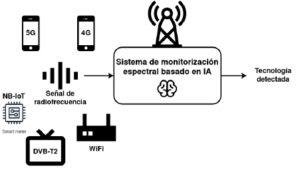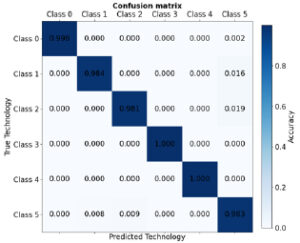We live in a hyper-connected world. Our smartphones, home automation systems or IoT devices used by some utilities are connected to highly complex communications networks that need to be monitored from a radioelectric point of view. In this monitoring of radiofrequency signals there is an essential function to prevent incidents such as interference or a mismatch in the operation of the equipment. For this reason, in the Cervera Open-VERSO Network of Excellence, we develop technologies that use Artificial Intelligence, specifically convolutional neural networks that can help to identify and classify the different signals, for example, 4G, 5G, Bluetooth and WiFi, among others.
Network performance monitoring
Spectral monitoring consists of obtaining the state of the electromagnetic spectrum in a given geographical location. By this we mean discovering the presence of radio frequency signals (detection) and characterising the detected signals. That is, describing their parameters (such as their bandwidth, the modulation used, their temporal activation patterns…), identifying their origin by means of the angle of arrival (localisation) and recognising whether that signal belongs to a known communications, radar or positioning technology (identification).
Cellular networks provide us with mobile communications services that we use every day in our 4G or 5G smartphones or in IoT devices, such as smart meters. These networks are extremely complex systems, with a huge number of elements: all the base stations with their antennas of the different operators and all the user terminals, UEs, that connect to these networks. For this reason, it is necessary for network operators to monitor the state of the spectrum assigned to them, to verify that there are no anomalies, due to intentional interference or malfunctioning equipment, that could affect the quality of the services they offer.
Convolutional neural networks that classify signals
Within Open-VERSO, we are developing radio frequency signal identification technologies based on Artificial Intelligence algorithms, more specifically on convolutional neural networks. Nowadays, most terrestrial communication systems use multicarrier modulations, one or another variant of OFDM (Orthogonal Frequency Division Multiplexing) with different time and frequency parameters. For this reason, it is a priority for a spectral monitoring system to be able to identify different types of signals. In this way it could classify the detected signals and identify whether they are 4G, 5G, WiFi, Bluetooth or digital terrestrial TV signals, just to give examples of communication systems using multicarrier modulations.
Concept of a spectral monitoring system that differentiates between different communications signals with multicarrier modulations.
In recent scientific publications, we have shown how to train a convolutional neural network to classify OFDM signals with different parameters from the samples of a signal capture. For example, with 3 dB signal-to-noise ratio the AI-based classifier is able to correctly identify the class of an OFDM signal among 6 different technologies. And with only 0 dB (same signal to noise power) the average accuracy is still above 90 %.
Confusion matrix at 3 dB signal to noise ratio showing how the system predicts with very high accuracy the correct technology of the signals.
Neural Networks with multiple uses
In conclusion, spectrum state awareness has important applications, both in the civilian domain (to monitor the state of cellular networks) and in the military domain (sensing the electromagnetic spectrum on the battlefield). The use of Artificial Intelligence techniques is showing very good results in several areas such as computer vision, so we also explored this approach to develop an Artificial Intelligence-based spectral monitoring system. Thus, within the Cervera Open-VERSO Network, the first approach has been the use of neural networks for the classification of multicarrier signals, which is a very common modulation in many modern communication systems.
Autor: Anxo Tato Arias, researcher-engineer in Advanced Communications Department at Gradiant
Open-VERSO is a network of excellence financed by the Cervera Program for Technological Centers, the national commitment to develop market-oriented research promoted by the Ministry of Science and Innovation and the Center for Industrial Technological Development (CDTI).






